How Porter used Fable to advance accessibility
Travel can be more difficult for people with disabilities – but it shouldn’t be. Over the past few years, Porter Airlines has been changing this inequitable reality by investing in accessibility. By conducting research and testing their products with assistive technology users on Fable’s platform, Porter has been able to make meaningful changes to the travelling experience.
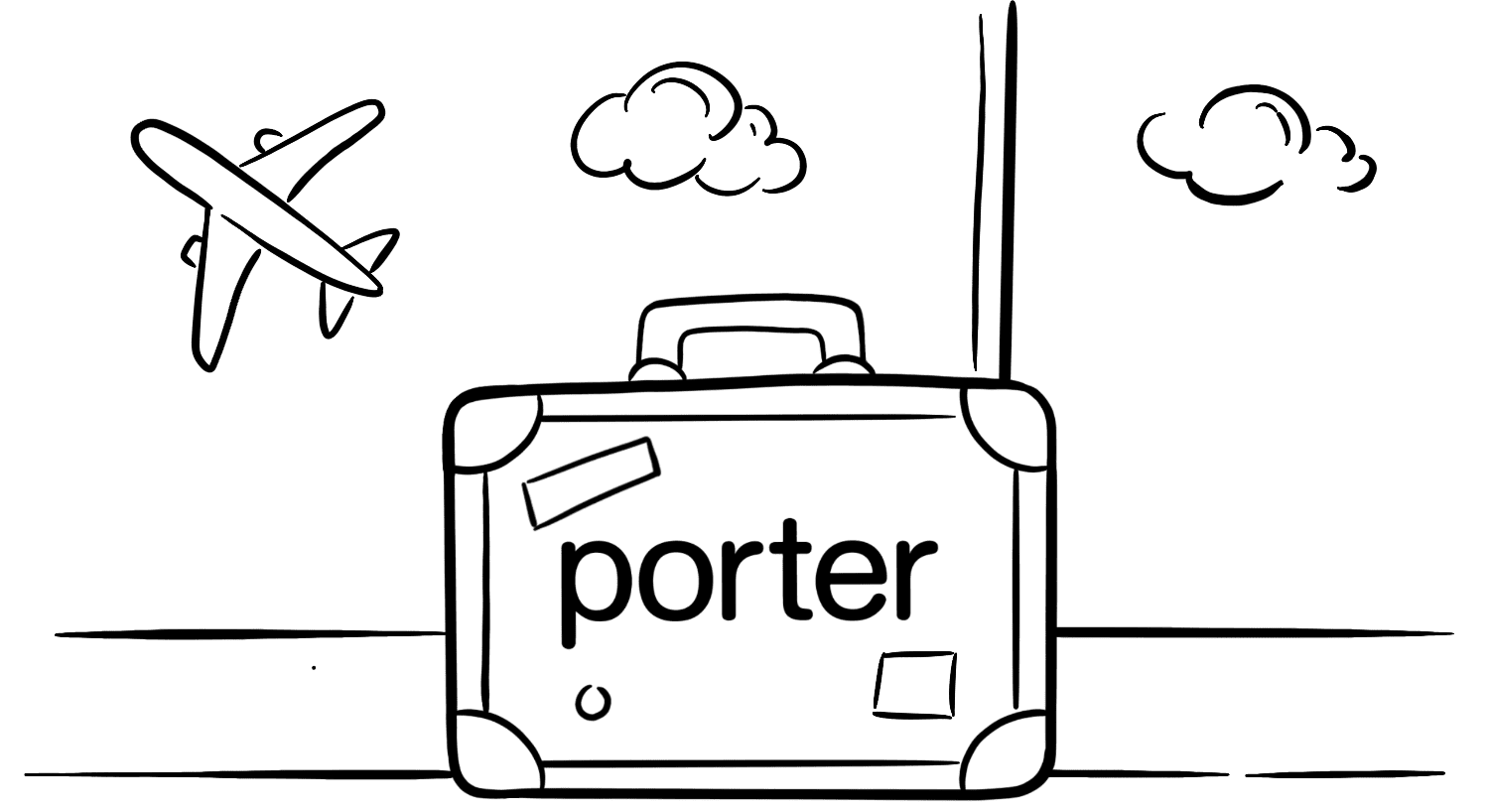
Helping people fly – refined
When Porter Airlines came to Toronto, it quickly gained a reputation for a better flying experience. It was fast, reliable, affordable, and easy. And with a seamless check-in experience – not to mention the complimentary beer and wine served in glassware – travelling with Porter seemed to counter many of the typical expectations about flying.
For nearly a decade, Porter has been investing heavily in embedding accessibility into their digital and design process to improve user experience. Similar to many organizations, Porter’s foray into accessibility began with manual and automated testing. The challenges with this approach soon became clear.
“It’s a faster process from point A to point B.”

Deanna Stacey
Vice President Digital, Loyalty & Solutions Delivery at Porter Airlines
“It’s a faster process from point A to point B.”
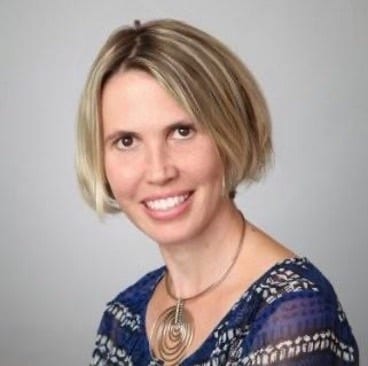
Deanna Stacey
Vice President Digital, Loyalty & Solutions Delivery at Porter Airlines
Realizing the importance of native users
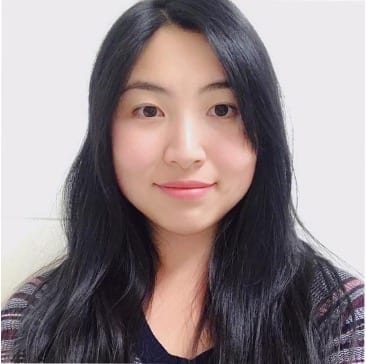
While automated tools enabled fast testing, they often weren’t reflective of the user experience of a native assistive technology user.
In the past, the Porter team was focused on testing component by component, rather than evaluating how users interact with the entire product. And because users often don’t complain outright, it wasn’t always clear what issues they were experiencing in the first place.
Passengers who use assistive technology are particularly underrepresented in travel – likely because the experience is often not very accessible, both physically and digitally. This presents a challenge for recruiting participants with accessibility needs for usability testing. Another challenge was that previously when getting user feedback, Porter typically asked people to come into their offices, meaning participants would have to overcome accessibility challenges including coordinating their commutes and possibly using technology that they weren’t familiar with.
Accessibility also presents a design challenge. When a designer doesn’t use assistive technology daily, they often aren’t looking at the same things or following accessibility users’ mental models in their design. Porter was looking to engage with more assistive technology users, as well as get feedback from across a diverse range of assistive technologies. Some users have a few different tools that they use, so it was important to get a variety of perspectives.
Due to some of these challenges, a UX researcher and analyst with Porter’s digital customer experience team, Dandi Feng, found she was not able to reliably test how users with various assistive technologies were engaging with the platform across mobile and desktop devices.
Porter determined it would be more effective to move away from relying on the goodwill of their customers with disabilities to provide feedback. And that’s when they found Fable.

Dandi Feng, UX Researcher and Analyst at Porter
Accessibility accelerates for takeoff
Porter began to work with Fable, an accessibility testing platform for digital teams, to test products for people with disabilities.
Consider the typical seat map in the flight booking process for a notable example of what Porter learned from assistive technology users.
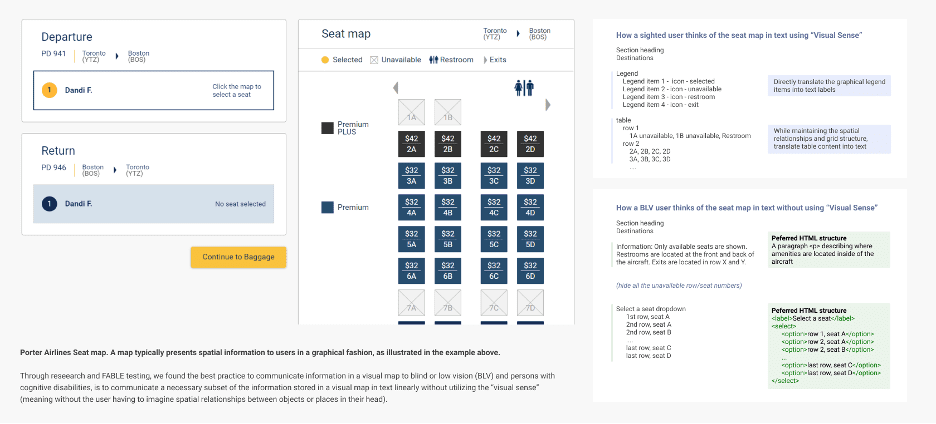
Previously, when Porter tried to make the visual seat map into a text-based user interface , they received feedback that it wasn’t easy for assistive technology users to navigate, so they asked the users “why?”
The feedback the team got was simple: “this is still designed for sighted users” – the interface was no longer a “graph,” but it was created using “graphical logic” and “visual sensibility.”
In a QA Session through Fable, a suggestion came from a tester to simply convey this information as a list. Dandi loved the idea and realized that this was something only a native assistive technology user would know; and that the team was over-complicating an easy solution.
Another example is that Porter occasionally seeks feedback from customers through use of questionnaires on the web. Typically, they would present options on the left side or right side of an interface (as either option will be understood by sighted users). However, Dandi and the team came to learn that order and structure matter for inclusive design. For example, finding an answer before a question in a text interface doesn’t make any sense in the case of blind users. Many instead had a strong preference for a linear order, as it’s logical and sequential. Learning this, the team was able to implement that linear framework into other components, integrating accessibility across their digital products.
An important learning is that while guidelines such as the WCAG may be instructive for making a component accessible from a technical perspective, they do not help designers to make conscious design decisions that suit the needs of assistive technology users. The insights that drive design decisions must come from research with users.
Accessibility drives the design of new features
For Porter, focusing on accessibility with Fable doesn’t simply fix existing features. It also drives the design of new ones.
Fable works step by step through the product development process to integrate people with disabilities. This workflow pairs very well with common user research methods, including those employed by Dandi and her team.
At the evaluative stage and in Task Analysis, a user experience researcher can set an objective and then break it down into subtasks. And for each step, a researcher can then identify where usability issues arise faster and more effectively with the help of Fable testers.
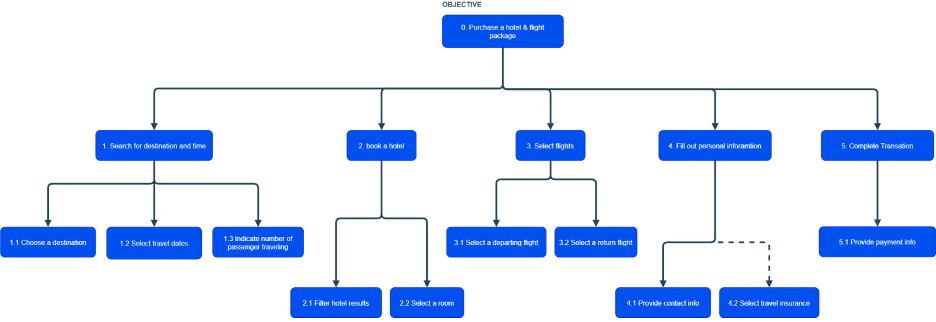
Fable has shifted the way that Porter can build accessible product components. As one of the key users of the platform, Dandi is now a knowledge broker for her larger team. During planning sessions, she can go through the insights from Fable testers and explain to the developers and the QA analysts what it means to, for example, change a graphical map into a list.
And now that Porter can get constructive feedback from assistive technology users, it has created a specific process and understanding for the team of how they go about researching and designing new features.
There is also a recognition that accessibility can be a competitive advantage that drives loyalty. If a user can easily access Porter’s services, they’ll likely return, because they know they can self-serve, rather than needing external help or enduring frustrating experiences.
One of the advantages that the digital team at Porter gained was that Fable made it easier to identify the most pressing pain points. The intermediary step between research and development was eliminated as researchers are now equipped with accessibility knowledge to provide solutions directly to the development team that go beyond user stories.
“The focus on accessibility has prompted rethinking many of our customer values and high-level design principles. We now have a more holistic point of view for different people with disabilities and want to ensure everyone can use our products as independently as possible.”

Deanna Stacey
Vice President Digital, Loyalty & Solutions Delivery at Porter Airlines
“The focus on accessibility has prompted rethinking many of our customer values and high-level design principles. We now have a more holistic point of view for different people with disabilities and want to ensure everyone can use our products as independently as possible.”

Deanna Stacey
Vice President Digital, Loyalty & Solutions Delivery at Porter Airlines
Accessibility benefits culture
Focusing on accessibility has also yielded several benefits for Porter’s team and culture.
For instance, Fable enabled the team to address the discrepancies in training related to accessibility. Working with Fable has helped Porter to increase internal awareness and strengthen design practices around accessibility.
Dandi invited her fellow team members to observe sessions with Fable testers to see how they naturally use their products. Fable also provides recordings of User Interviews, which help Porter’s digital team to identify the specific issues that cause problems. The sessions and recordings help product teams understand when people don’t know how to do something, or if it’s not clear. Then teams can iterate and test what they’ve learned.
Fable has also contributed to helping the team prioritize. The primary research of user experiences provided by Fable alongside secondary information, has helped Porter to plan for what to focus on. For example, learning from a WebAIM report that over 70% of screen reader users on mobile use VoiceOver enabled their team to prioritize which technologies Porter would support. And then engaging with Fable testers helped to identify the most important barriers on mobile.
“Previously, accessibility was done late in the game and assigned towards our ‘maintenance’ function. But the team runs differently now. They separate all the accessibility tickets into one ‘epic’ within their product roadmap. Creating a specific area for accessibility makes it much easier for us to monitor progress and issues. And our team now draw issues into sprints with the same priority as other product issues.”

Deanna Stacey
Vice President Digital, Loyalty & Solutions Delivery at Porter Airlines
“Previously, accessibility was done late in the game and assigned towards our ‘maintenance’ function. But the team runs differently now. They separate all the accessibility tickets into one ‘epic’ within their product roadmap. Creating a specific area for accessibility makes it much easier for us to monitor progress and issues. And our team now draw issues into sprints with the same priority as other product issues.”

Deanna Stacey
Vice President Digital, Loyalty & Solutions Delivery at Porter Airlines
Working on accessibility continuously, at speed
The removal of intermediary steps has allowed the culture of the product team to move faster on, and prioritize, accessibility issues effectively.
Another aspect that helps is that Fable permits continuous user research with people with disabilities, which then enables Porter to create accurate and representative accessibility personas. These personas serve to further break down the conventional stereotypes of users with accessibility needs.
Overall, Porter now focuses more heavily on enabling independence and learning for people with disabilities. This focus has allowed product team members like Dandi to deepen their roles. Particularly in the case of UX researchers, who often inherently have an empathetic nature, a focus on accessibility allows their empathy to flourish.
Moving forward
Policymakers are also taking bigger steps to enable passengers with disabilities to travel more independently and comfortably. The Air Carrier Access Act of the US Department of Transportation was up until early 2010, focused on the accessibility of the built environment e.g., ground assistance and mobility. Now, there’s an increasing focus on ensuring that the digital experience is equally accessible.
And this is now a space where Porter is soaring ahead.
“Porter is focused on providing an accessible journey, across devices. Because people deserve independence. We’re focused on the critical digital touchpoints, like search and booking, and retest them regularly to validate that they continue to be accessible. Moving forward, we’re also committed to doing more to incorporate accessibility testing in the building phase, not just the validation one. And we’re proud of the work we do with Fable to achieve this.”

Deanna Stacey
Vice President Digital, Loyalty & Solutions Delivery at Porter Airlines
“Porter is focused on providing an accessible journey, across devices. Because people deserve independence. We’re focused on the critical digital touchpoints, like search and booking, and retest them regularly to validate that they continue to be accessible. Moving forward, we’re also committed to doing more to incorporate accessibility testing in the building phase, not just the validation one. And we’re proud of the work we do with Fable to achieve this.”

Deanna Stacey
Vice President Digital, Loyalty & Solutions Delivery at Porter Airlines
Additional information
If you’re interested, learn more about Fable’s work in digital accessibility. If you are an assistive technology user and are interested in remote work opportunities, check out our community page to learn about becoming an accessibility tester with Fable. For more information on accessibility at Porter and its accessibility efforts, visit the Porter website.
